Foreword / YouTube Video Review
These speakers were loaned to me for review by Monoprice directly. I was not paid or given anything for this review and Monoprice has not seen this review yet and has had no say in what I publish.
Update: 05/07/2022: Monoprice contacted me shortly after seeing my initial review of the B6 bookshelf (posted December 2021) and let me know they realized there was an issue with their tweeter assembly (discussed more in the video below). They provided me a new assembly for each of their Encore speakers they had sent me a few months ago. This update is current on all their speakers and has been for some months now. I’m just now getting around to reviewing the speakers with the updated tweeter assembly.
The review on this website is a brief overview and summary of the objective performance of this speaker. It is not intended to be a deep dive. Moreso, this is information for those who prefer “just the facts” and prefer to have the data without the filler. The video below has more discussion.
Information and Photos
Some specs from the manufacturer can be found here:
The Monolith™ Encore series of speakers brings astounding audio performance to any room! Featuring a silk dome tweeter with distinctive tweeter waveguide, powerful woofers, and ultra‑sturdy cabinets, the Encore series delivers affordable, high performance audio. Immersive, room filling sound, an accurate midrange, and crisp, natural highs ensure an exciting and pleasurable listening experience!
- Color and Finish: Black PVC
- Woofer: 1x 6.5" Long Fiber Pulp Cone with NBR Surround
- Tweeter: 1x 25mm Silk Dome with Waveguide
- Enclosure: Vented MDF cabinet with horizontal shelf bracing
- Frequency Response: 49Hz ~ 20kHz
- Nominal Impedance: 4 ohms
- Sensitivity: 85.0dB (2.83V@1m)
- Crossover: Low: 1.2kHz @12dB/octave
- Crossover: High: 1.2kHz @18dB/octave
- Inputs: 5‑way binding posts
- Dimensions: 15.7" x 7.9" x 9.9" (400 x 201 x 251 mm)
- Weight: 15.4 lbs. (7.0 kg)
Price is approximately $179 USD each, making a pair cost about $360 USD.
If you are interested in purchasing this speaker, please consider using the following affiliate link which earns me a small commission at no additional cost to you: Buy from Monoprice
Check out this gloss top (and bottom, not pictured). This is unexpected for this price range.
Grille and back.
CTA-2034 (SPINORAMA) and Accompanying Data
All data collected using Klippel’s Near-Field Scanner. The Near-Field-Scanner 3D (NFS) offers a fully automated acoustic measurement of direct sound radiated from the source under test. The radiated sound is determined in any desired distance and angle in the 3D space outside the scanning surface. Directivity, sound power, SPL response and many more key figures are obtained for any kind of loudspeaker and audio system in near field applications (e.g. studio monitors, mobile devices) as well as far field applications (e.g. professional audio systems). Utilizing a minimum of measurement points, a comprehensive data set is generated containing the loudspeaker’s high resolution, free field sound radiation in the near and far field. For a detailed explanation of how the NFS works and the science behind it, please watch the below discussion with designer Christian Bellmann:
The reference plane in this test is at the tweeter.
Measurements are provided in a format in accordance with the Standard Method of Measurement for In-Home Loudspeakers (ANSI/CTA-2034-A R-2020). For more information, please see this link.
CTA-2034 / SPINORAMA:
The On-axis Frequency Response (0°) is the universal starting point and in many situations it is a fair representation of the first sound to arrive at a listener’s ears.
The Listening Window is a spatial average of the nine amplitude responses in the ±10º vertical and ±30º horizontal angular range. This encompasses those listeners who sit within a typical home theater audience, as well as those who disregard the normal rules when listening alone.
The Early Reflections curve is an estimate of all single-bounce, first-reflections, in a typical listening room.
Sound Power represents all of the sounds arriving at the listening position after any number of reflections from any direction. It is the weighted rms average of all 70 measurements, with individual measurements weighted according to the portion of the spherical surface that they represent.
Sound Power Directivity Index (SPDI): In this standard the SPDI is defined as the difference between the listening window curve and the sound power curve.
Early Reflections Directivity Index (EPDI): is defined as the difference between the listening window curve and the early reflections curve. In small rooms, early reflections figure prominently in what is measured and heard in the room so this curve may provide insights into potential sound quality.
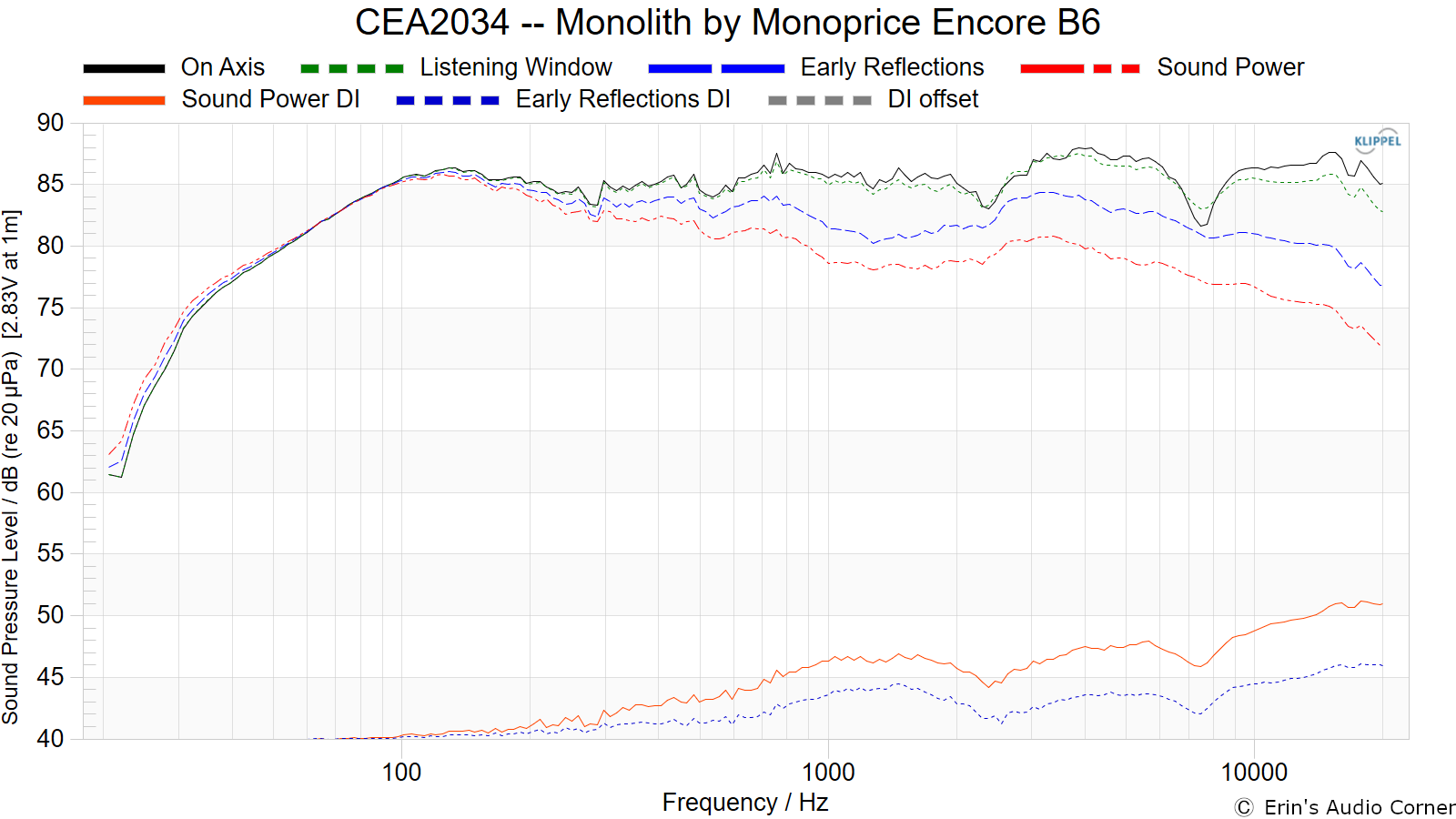
Early Reflections Breakout:
Floor bounce: average of 20º, 30º, 40º down
Ceiling bounce: average of 40º, 50º, 60º up
Front wall bounce: average of 0º, ± 10º, ± 20º, ± 30º horizontal
Side wall bounces: average of ± 40º, ± 50º, ± 60º, ± 70º, ± 80º horizontal
Rear wall bounces: average of 180º, ± 90º horizontal

Estimated In-Room Response:
In theory, with complete 360-degree anechoic data on a loudspeaker and sufficient acoustical and geometrical data on the listening room and its layout it would be possible to estimate with good precision what would be measured by an omnidirectional microphone located in the listening area of that room. By making some simplifying assumptions about the listening space, the data set described above permits a usefully accurate preview of how a given loudspeaker might perform in a typical domestic listening room. Obviously, there are no guarantees, because individual rooms can be acoustically aberrant. Sometimes rooms are excessively reflective (“live”) as happens in certain hot, humid climates, with certain styles of interior décor and in under-furnished rooms. Sometimes rooms are excessively “dead” as in other styles of décor and in some custom home theaters where acoustical treatment has been used excessively. This form of post processing is offered only as an estimate of what might happen in a domestic living space with carpet on the floor and a “normal” amount of seating, drapes and cabinetry.
For these limited circumstances it has been found that a usefully accurate Predicted In-Room (PIR) amplitude response, also known as a “room curve” is obtained by a weighted average consisting of 12 % listening window, 44 % early reflections and 44 % sound power. At very high frequencies errors can creep in because of excessive absorption, microphone directivity, and room geometry. These discrepancies are not considered to be of great importance.

Horizontal Frequency Response (0° to ±90°):

Vertical Frequency Response (0° to ±40°):

Horizontal Contour Plot (normalized):

Vertical Contour Plot (normalized):

“Globe” Plots
Horizontal Polar (Globe) Plot:
This represents the sound field at 2 meters - above 200Hz - per the legend in the upper left.
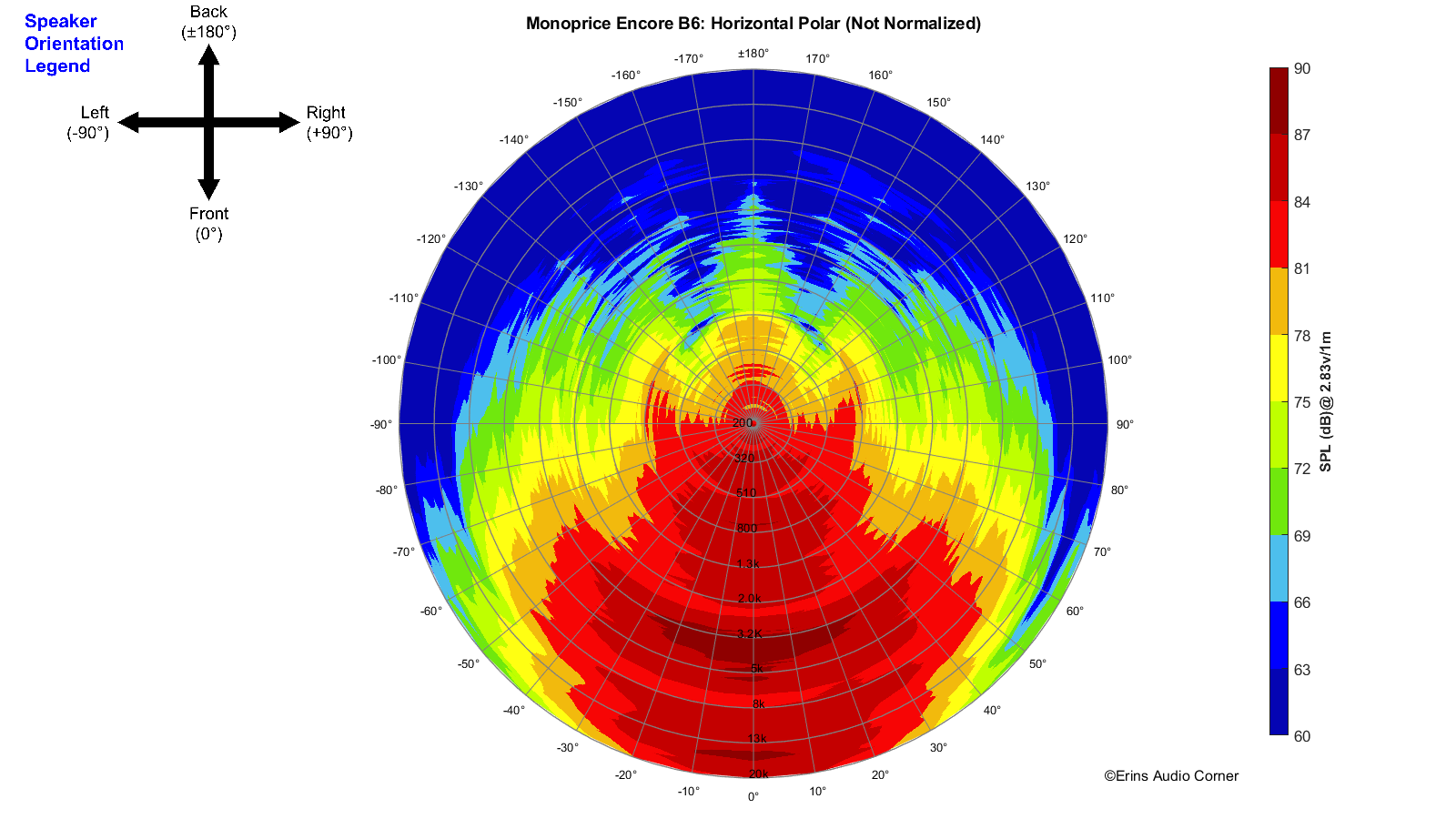
Vertical Polar (Globe) Plot:
This represents the sound field at 2 meters - above 200Hz - per the legend in the upper left.

Additional Measurements
On-Axis Response Linearity

Impedance Magnitude and Phase + Equivalent Peak Dissipation Resistance (EPDR)
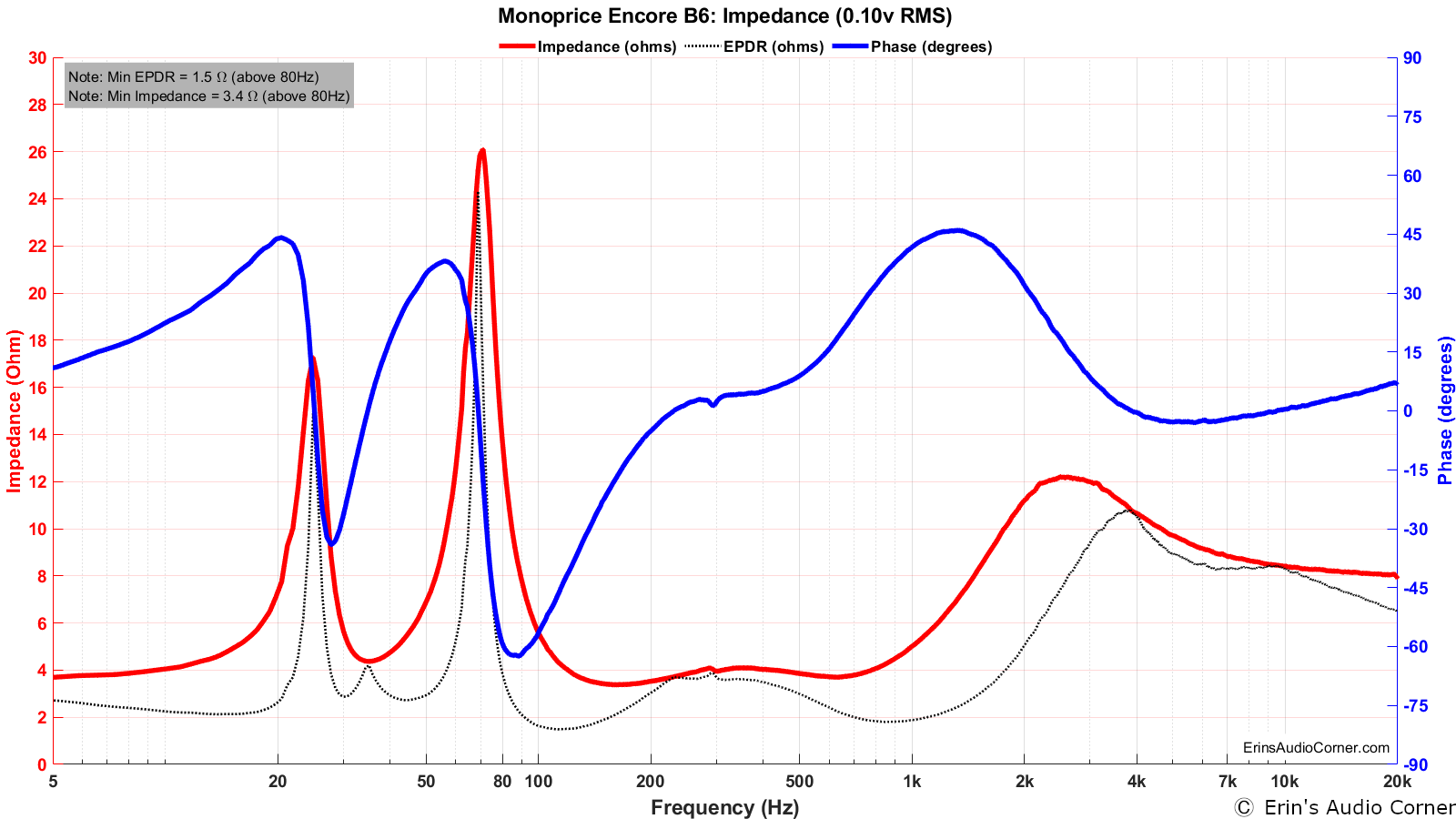
Harmonic Distortion
Harmonic Distortion at 86dB @ 1m:
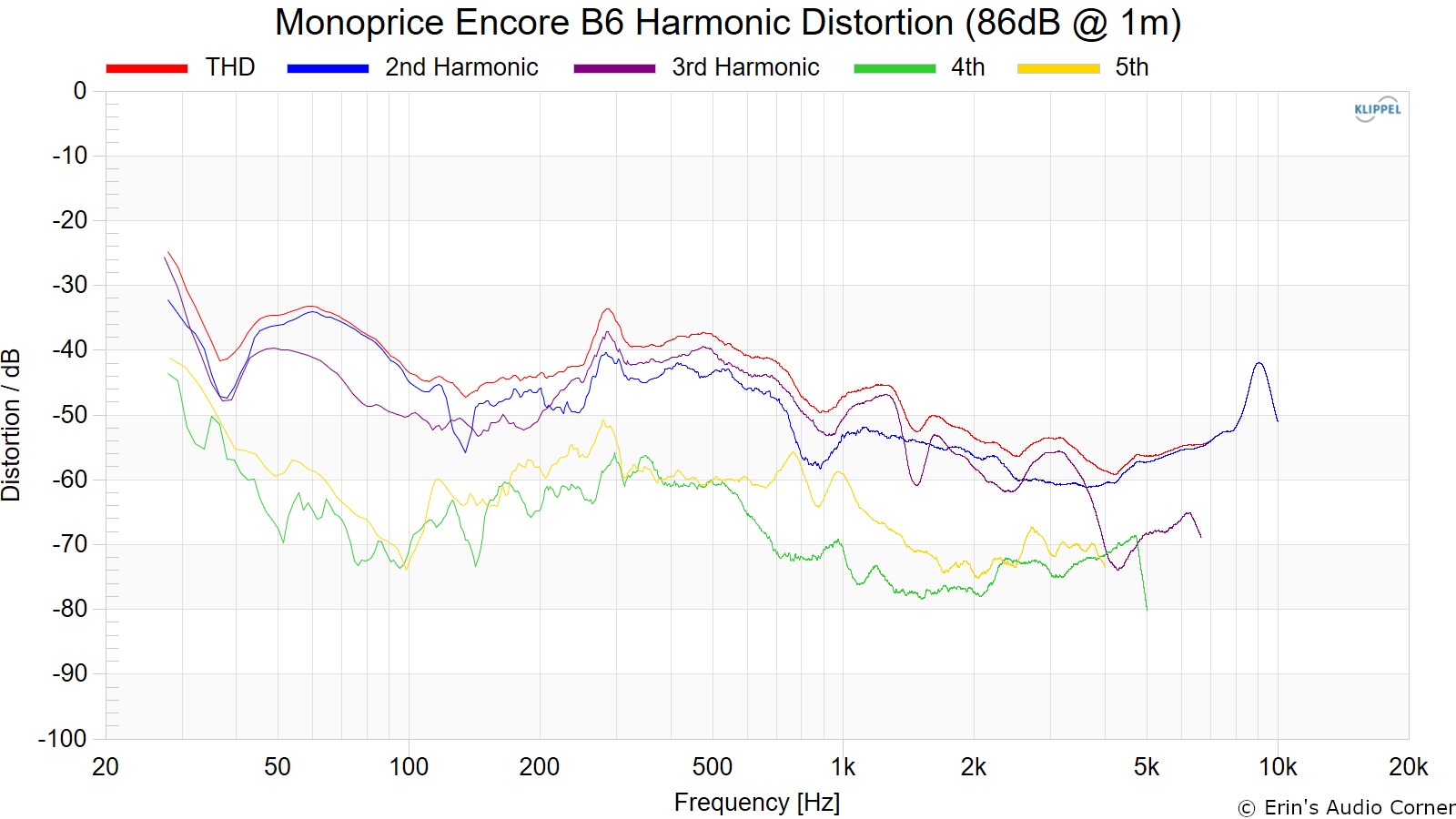
Harmonic Distortion at 96dB @ 1m:
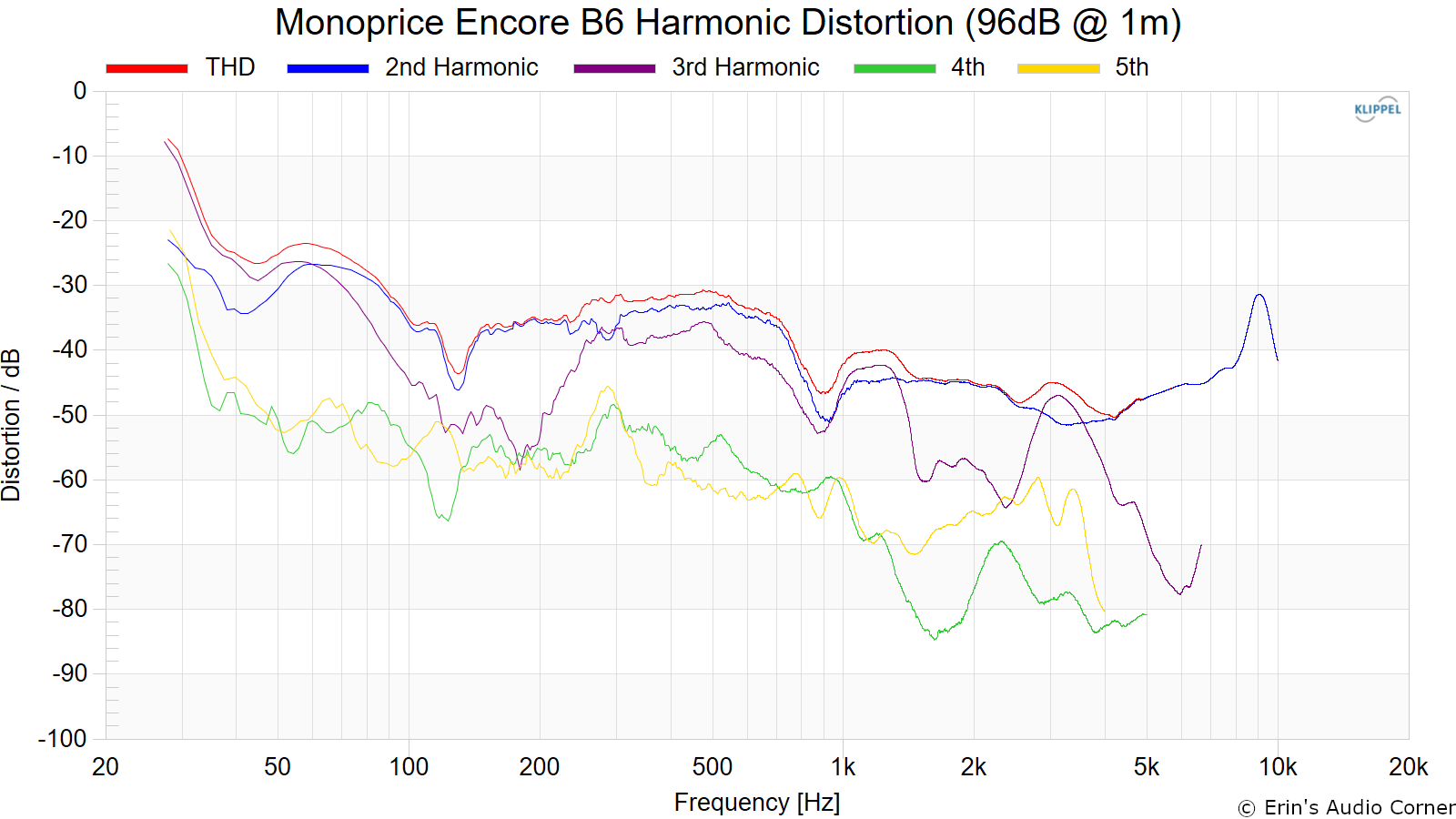
Dynamic Range (Instantaneous Compression Test)
The below graphic indicates just how much SPL is lost (compression) or gained (enhancement; usually due to distortion) when the speaker is played at higher output volumes instantly via a 2.7 second logarithmic sine sweep referenced to 76dB at 1 meter. The signals are played consecutively without any additional stimulus applied. Then normalized against the 76dB result.
The tests are conducted in this fashion:
- 76dB at 1 meter (baseline; black)
- 86dB at 1 meter (red)
- 96dB at 1 meter (blue)
- 102dB at 1 meter (purple)
The purpose of this test is to illustrate how much (if at all) the output changes as a speaker’s components temperature increases (i.e., voice coils, crossover components) instantaneously.
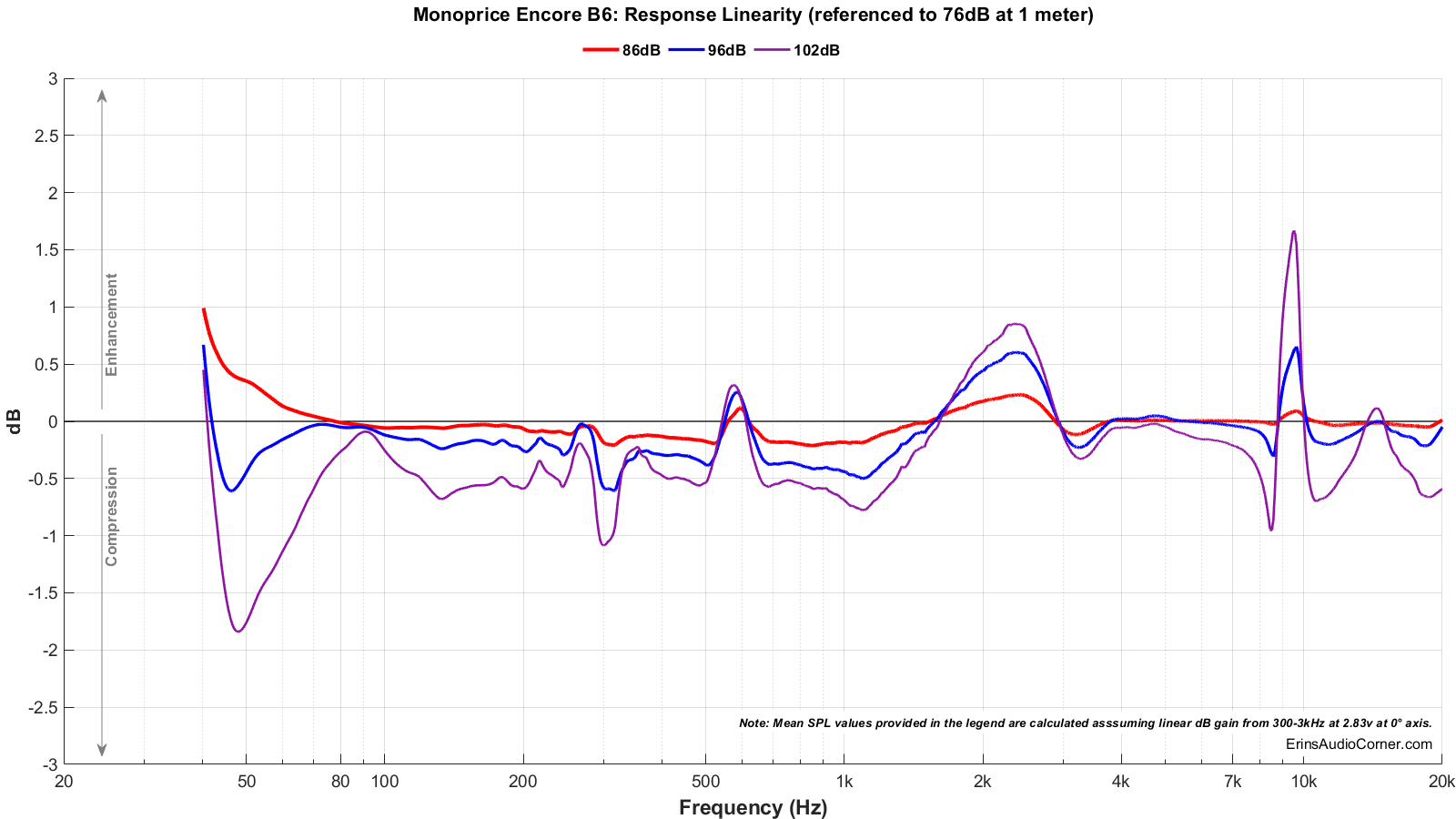
With EQ
For kicks, I used the above data to generate some EQ profiles in my miniDSP and then re-measured the speaker. Note it doesn’t change the directivity (as expected).
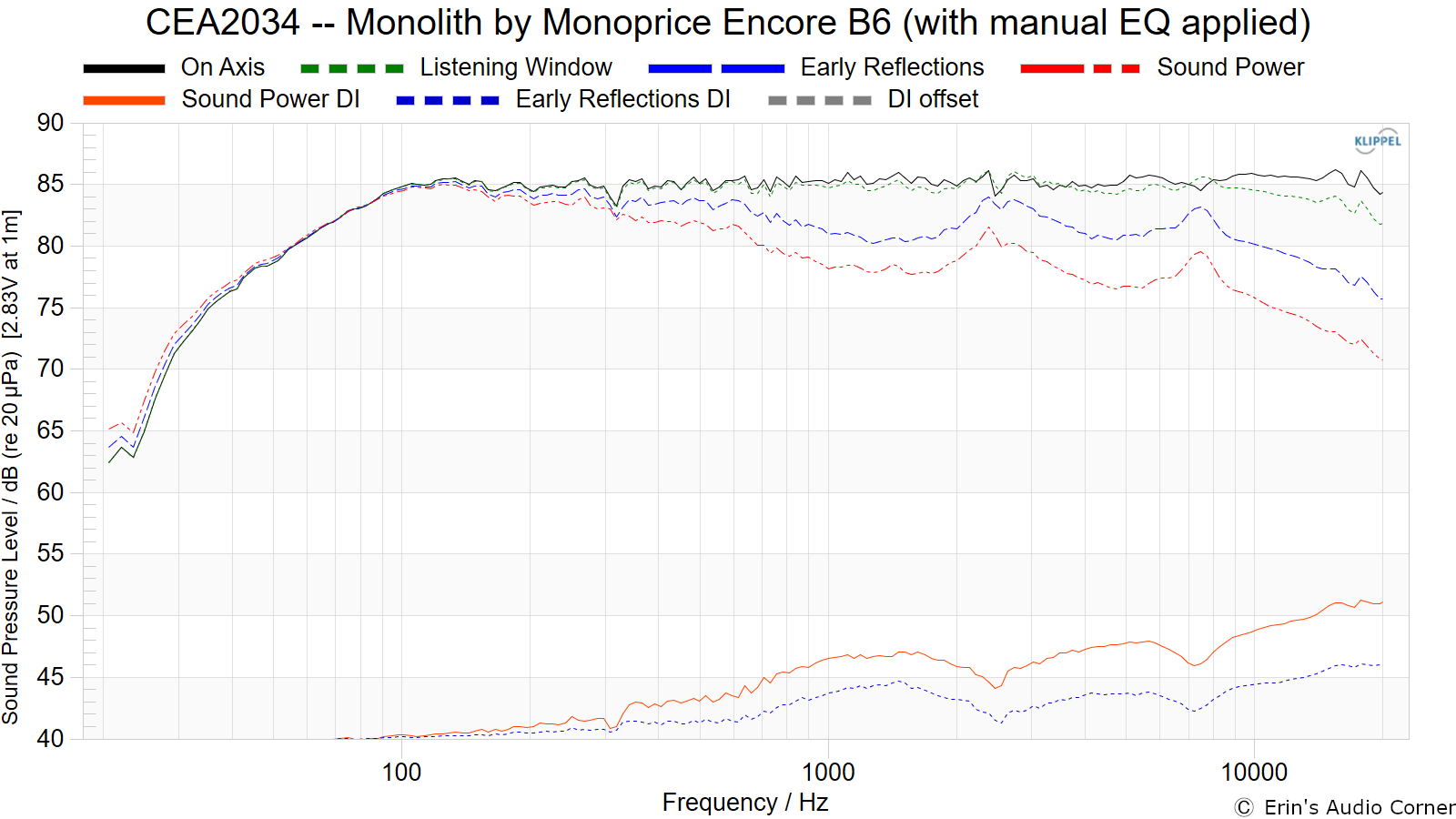
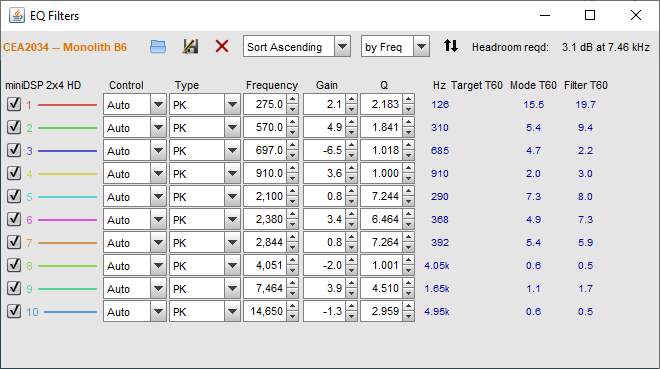
Parting / Random Thoughts
If you want to see the music I use for evaluating speakers subjectively, see my Spotify playlist.
I always listen to speakers before I measure them. This ensures I am not swayed by the measurements before I listen.
- The bass is pretty darn nice. In my case, the speakers were away from the walls about 3 feet and while there wasn’t a lot of low bass, the midbass had a nice ‘attack’ to it. I attribute some of this to the mild bump at 100Hz but also to the extended port tuning that puts the F3 point at about 68Hz with an F10 at about 37Hz. Placement near a wall will help this but since you have a port here, you’ll need to be careful. It might be worth you taking the time to try stuffing a rag in the port and putting the speaker a bit closer to the wall (say, like you might a surround speaker in a home theater) and see if you like the response.
- While the distortion profile is respectable, I still recommend treating these as you would a similar sized bookshelf speaker by crossing them over to a subwoofer. The typical electrical filter on AVRs of 80Hz would be a reasonable place to start here.
- I use my music app and applied a single band of EQ at 4kHz (-3dB, Q = 3) and found the speaker to be much more pleasant. When toggling the EQ on/off it was pretty evident that the 3-4kHz peak shown in the Estimated In-Room response was causing a bit of ’edge’ that I wasn’t fond of.
- Horizontal radiation in my listening session was nice. Not super wide, but it seemed to be reasonably even in the room with respect to the on-axis response vs what was reflected and how that impacts the overall timbre of the sound. Though, as expected, the waveguide does narrow the response in the higher frequencies, it isn’t extreme and yields a horizontal radiation pattern of about ±50° from 800Hz to 10kHz. The radiation is about ±75° from 300Hz to 800Hz and below this it is going omnidirectional.
While the data isn’t perfect, the attributes of this speaker relative to its price make it an option worth considering. From sound quality to looks, it’s a little of everything at a relatively low price. You get decent response and you get a nice looking speaker with the typical black veneer on the sides but the added gloss top and bottom that take it from a “plain” speaker to one that might fool your friends and/or significant other … heck, maybe even yourself, into thinking you spent a couple hundred bucks more than you did.
As stated in the Foreword, this written review is purposely a cliff’s notes version. For more details about the performance (objectively and subjectively) please watch the YouTube video.
Support the Cause
If you find this review helpful and want to help support the cause there are a few ways you can do so below. Your support helps me pay for new items to test, hardware, miscellaneous items needed for testing and costs of the site’s server space and bandwidth. Any help is very much appreciated.
Or using my Monoprice affiliate link or Amazon affiliate link which helps me gain a small commission at no additional cost to you.
You can also join my Facebook and YouTube pages if you’d like to follow along with updates.